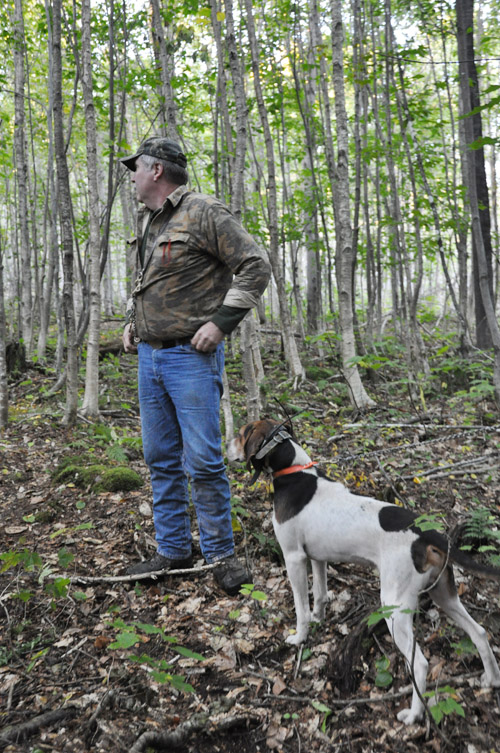Fall in Maine brings many opportunities to hunt. Maine’s moose hunt has been called the hunt of a lifetime, and hunting the mountains of northern Maine can give you a shot at perhaps the buck of a lifetime.
Yet with the exception of 2004, when a referendum focused intense scrutiny on them, bear hunters enjoy exceptional big-game hunting throughout much of the state in relative anonymity.
Maine has one of the largest black bear populations in the country and the most bears east of the Mississippi, with an estimated 23,000.
“Maine’s bear population is growing,” says Jennifer Vashon, the state’s top bear biologist. The question is how fast.
Vashon estimates that areas of northern Maine already have population densities of over one bear per square mile.
In order to keep Maine’s bear population at its current level, IFW would like to see a harvest of 3,000 to 4,000 bears annually. Last year, hunters killed 3,486 bears, but the previous four years saw a bear kill of under 3,000 each year.
How fast the population is growing may be answered as early as next year. IFW has three bear study areas in the state where bears are collared and tracked, and reproductive and mortality rates are monitored. Biologists are now using GPS radio collars to get an even more accurate picture of a bear’s home range.
In addition, biologists have also started a voluntary tooth collection as part of their research. A bear’s tooth reveals a bear’s age, much like the age rings on a tree. collecting age data over a period of five years, biologists can start to reconstruct the population. These two tools will allow Maine’s bear biologists to come up with a more accurate bear population estimate.
Make no mistake, bear hunting in Maine is popular. According to license sale data from the Department of Inland Fisheries and Wildlife, there are just as many bear hunters in Maine as there are waterfowl hunters.
The state sells nearly as many bear permits as bowhunting licenses. License and permit revenue from bear hunters exceeds $1.2 million annually.
And if you wonder what drives Maine’s nonresident hunters, look no further than the bear hunt. Over 25 percent of all nonresident big-game hunters come to Maine to hunt bear.
Nonresident bear hunters are also going home happy. Last year, 2,208 nonresident bear hunters were successful. contrast, just 1,448 nonresident deer hunters got their deer.
Bob Parker, a Registered Maine Guide and outfitter who has been operating Stony Brook Outfitters with his wife Jaye since 1980, is well aware of the importance of Maine’s bear hunt. He knows the hunt provides both an economic boost to rural areas of Maine, and keeps the bear population at a manageable level.
Parker is located in western Maine, and his customers — mostly nonresidents — hunt bear in the northern parts of Oxford, Franklin and Somerset counties.
Parker puts 15,000 to 20,000 miles on his truck during bear season. The night I was at his lodge, there were more than 10 hunters there, and each was fed a wonderful supper and breakfast.
Parker employs several guides, the number varying on how many sports are in camp.
He is a skilled hunter. In the past, Parker and his dogs have been called upon by Inland Fisheries and Wildlife to track endangered lynx in northern Aroostook county as part of a research study; and also by the Maine Warden Service several times to run his dogs on the scent of nuisance bears to scare them away from an area.
Recently I was able to accompany Parker and two sports on a bear hunt. We were hunting with a father, John, and his son Zack, from Connecticut. It was the son’s second trip up to Stony Brook. Last year, he came and hunted over bait. This year, Zack brought his father and they were hunting bear with dogs.
On the first day of the hunt, Parker’s dogs picked up the scent of a bear, and treed it. We hiked in an hour and 15 minutes from the nearest road to where the bear was located.
As we left the truck, I asked one of the guides there how far he thought it was to the bear’s location. He replied, “It’s not a question of how far in, it’s just a question of how far up.”
We did make in there, and Zack came out with his bear. Parker estimated the bear was close to 300 pounds. Zack and his dad hunted the rest of the week, and even though they saw three other bears, John didn’t bring one home. But he did bring wonderful memories.
“Unfortunately, my dad didn’t shoot a bear, but we did see a few more that week,” wrote Zack in an e-mail. “The dogs did great, got two treed and another in a cave, but he decided to pass them up. We both had a lot of fun just being outdoors.”
Which is what hunting with family and friends is all about.
Mark Latti is a former public information officer for the Maine Department of Inland Fisheries and Wildlife and a Registered Maine Guide. He can be reached at: mlatti@gmail.com
Send questions/comments to the editors.



Success. Please wait for the page to reload. If the page does not reload within 5 seconds, please refresh the page.
Enter your email and password to access comments.
Hi, to comment on stories you must . This profile is in addition to your subscription and website login.
Already have a commenting profile? .
Invalid username/password.
Please check your email to confirm and complete your registration.
Only subscribers are eligible to post comments. Please subscribe or login first for digital access. Here’s why.
Use the form below to reset your password. When you've submitted your account email, we will send an email with a reset code.